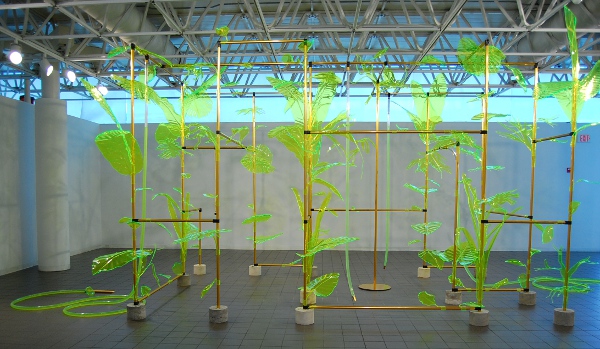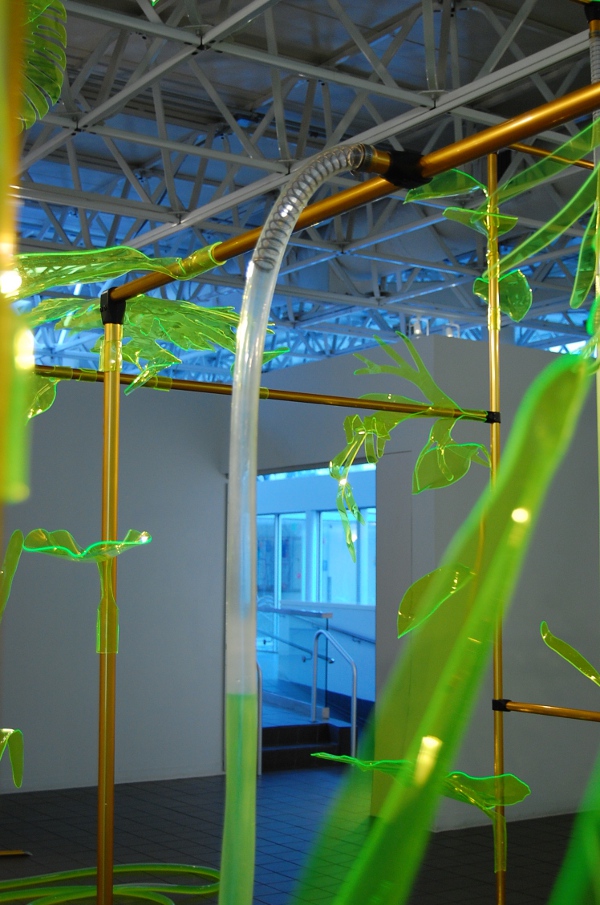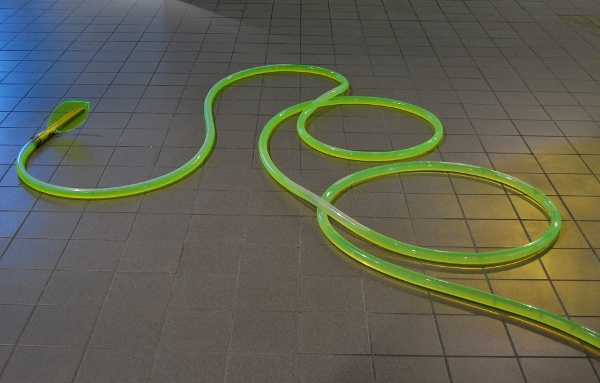
Thomas Glassford constructs an acidic, synthetic garden at Moore
The Galleries at Moore College of Art & Design are right in the thick of it for the exhibition “Afterglow” by Thomas Glassford. An enormous, scaffold-like construction currently resides in an entire room of Moore’s gallery space and confronts visitors with forms that are both natural and synthetic, confounding perceptions and warnings of a dystopian future.
Round concrete abutments stand solidly on the floor, bestowing the analogy of a ‘concrete jungle’ with some literality. Instead of roots, the trunks of these trees anchor themselves firmly with molded slabs of artificial stone. Golden aluminum bars rise from these bases and connect to one another at right angles. While the geometric perfection of the framework is far from your average forest, the plumes of leaves which extend from the metallic structure seem flexible and alive – if only they weren’t made of rigid plastic.
A closeup of the concrete base, metal pipe, and plastic leaves.
All of the leaves are translucent and modeled after realistic photosynthetic bodies. It’s almost as if a future natural history museum had to demonstrate plant life to a planet devoid of life. The green color of the leaves is obviously a nod to the chlorophyll in actual autotrophic organisms, except its hue is also bright and obnoxious… if not noxious. Toxic waste spills and radioactivity surely come to mind, and if it weren’t already evident, this exhibit quickly becomes an environmentally charged message.
Springs and fluid in the attached tubes.
While functional leaves collect energy from the sun like solar panels, these manifestations allow light to pass through almost unhindered. In a sense, they are like ghosts of what they represent: phantom leaves that merely distort and refract light waves instead of utilizing them for practical processes.
Some of the tubes coil down along the floor.
Tubes filled with oozing, green liquid and strange springs connect various parts of the installation and coil up on the floor. These components make it seem like some type of android plant or at least some sort of bizarre laboratory experiment. It’s as if some mad scientist had constructed a hydroponic process to resurrect ancient species of plant life. With global warming and extinction becoming growing problems in the face of human interference with the ecosystem, it doesn’t seem entirely implausible that one day some botanical Victor Frankenstein may need to try and correct the damage we’ve already done.
Glassford’s installation raises important ecological concerns, but as a visual work it is relatively bold and verdant. Seemingly part jungle gym, part radioactive greenhouse, “Afterglow” is an intelligent and stimulating work of art to explore and ponder with both childlike curiosity and scientific scrutiny. It will be on display at Moore through March 16.
Moore College of Art & Design is located at 20th Street & The Benjamin Franklin Parkway, Philadelphia; 215-965-4027; www.thegalleriesatmoore.org.
Recent Content
-
Artsarticle ·
-
Artsarticle ·
-
Artsarticle ·




